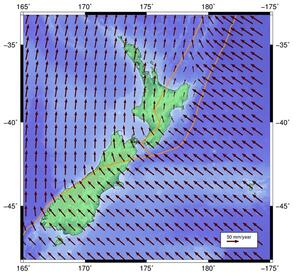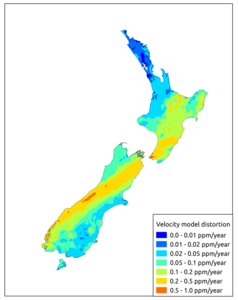The New Zealand Geodetic Datum 2000 deformation model is part of the framework (or rules) that defines New Zealand Geodetic Datum (NZGD2000). NZGD2000 provides consistent and unchanging coordinates even though New Zealand is moving and deforming under the influence of the Australian and Pacific Plates.
When NZGD2000 was defined, it aligned with the International Terrestrial Reference Frame 1996 (ITRF96) on 1 January 2000 (epoch 2000.0). The deformation model represents the horizontal movement of tectonic plates and deformation from significant earthquakes since then.
International Terrestrial Reference Frame (ITRF)
NZGD2000 coordinates are usually calculated by connecting to an existing geodetic or cadastral mark from resources like the Geodetic Database or Landonline. They can also be generated using the PositioNZ - Post Processing service, or transformed from other datums using the Toitū Te Whenua online coordinate converter.
LINZ Geodetic database - spatial view
Landonline
PositioNZ - Post Processing Service
Online coordinate converter
Note that the deformation model is a time-dependent transformation, so conversion between NZGD2000 and global datums requires a time at which the global datum coordinate applies. This is usually the time of the measurement.
If you use coordinates from other sources or choose not to use the NZGD2000 deformation model, you should consider the impact of the expected deformation and the accuracy and consistency of coordinates. When working on a larger scale the larger errors of a metre or so may be acceptable, and it may be safe to ignore the deformation model. In situations where high precision and local accuracy are vital, the deformation model helps ensure accuracy.
The impact of the NZGD2000 deformation model
The NZGD2000 deformation model is time-dependent, so in 2000 the NZGD2000 coordinates were similar to WGS84 (World Geodetic System 1984), also known as GPS (Global Positioning System) coordinates. It has been common practice to ignore the deformation model in many situations, and many geospatial and positioning software applications cannot transform coordinates correctly between NZGD2000 and the global datums.
World Geodetic System 1984 (WGS84)
As more time passes since the reference date of 1 January 2000 (epoch 2000.0), using NZGD2000 without accounting for the deformation model may lead to inaccuracies and inconsistencies in the coordinates produced. In general, there are two types of error that must be considered when deciding if the NZGD2000 deformation model is required.
The first type of error caused by the global motion of the tectonic plates. As shown in the image below, the coordinates of points in New Zealand are changing at rate of approximately 5cm per year when compared to ITRF96. In this model we see the Pacific Plate moving in a north-western direction and the Australian Plate moving in a northern direction.

Plate-fixed model showing the average plate tectonic movement in New Zealand relative to the International Terrestrial Reference Frame 1996 (ITRF96). This diagram shows vectors of approximately 5cm a year (north-west for the Pacific Plate and north for the Australian Plate) superimposed over a map of New Zealand.
This means that treating WGS84 coordinates as equivalent to NZGD2000 has an associated error of 5cm per year since 2000, or 1.25m in 2025. This error may be acceptable for low accuracy applications, such as in a recreational (or handheld) GPS unit.
The second type of error is the internal distortion of NZGD2000, which compromises the relative accuracy between local points within the datum. This occurs in areas where the tectonic plates are locked. As shown in the image below, the distortion is up to 0.7mm per km per year around Wellington and the Southern Alps. However, in the northwest and southeast of New Zealand it is much less.

Distortion of the NZGD2000 datum due to continuous plate tectonic deformation.
This means that ignoring internal distortion could lead to an error of 0.7mm per km for each year since 2000, which for a 10km line in 2025 adds up to 17.5cm. This distortion is accounted for by using the deformation model.
NZGD2000 models and patches
The NZGD2000 deformation model has 2 main components:
- a secular velocity model, representing horizontal tectonic plate movements
- ‘patches’ which consider specific deformation events like earthquakes, and may include vertical deformation.
As discussed above, the secular model accounts for the deformation of New Zealand due to the convergence of the Australian and Pacific Plates. This results in a deformation rate of around 5cm per year across the entire country. Additionally, internal strain of up to 0.7mm per year occurs in parts of the country.
The deformation model is periodically updated to account for deformation due to earthquakes and as our measurement of the deformation becomes more accurate.
Deformation event (earthquake) patches are applied in 2 ways:
Shapeforward patches modify the deformation model to represent the earthquake movement, but do not change the coordinates of marks
Shapereverse patches are used when the coordinates of points are updated to reflect the earthquake deformation. The reverse patch is used in the deformtion model to calculate coordinates at a time before the earthquake.
Forward patches added as a layer to the deformation model, requiring minimal action from most users (though advanced users may need to download the newest model version).
Reverse patches can cause significant disruption because all coordinates in the affected area are updated to reflect the deformation that has occurred. They are the best tool for reinstating the datum after major earthquakes, like the Canterbury earthquake sequence of 2010 to 2012, which caused several metres of deformation – a forward patch would not be able to maintain the relative accuracy of local coordinates.
Videos
Toitū Te Whenua, in partnership with the University of Otago and Survey and Spatial New Zealand, have produced a series of videos to help explain the NZGD2000 deformation, its application and tools.
View NZGD2000 Deformation Model videos on our YouTube channel: NZGD2000 deformation model - YouTube
Updates and versions of the NZGD2000 deformation model
The current version of the deformation model can be downloaded directly:
This package includes:
- the deformation model in a set of CSV files
- documentation about how to use the model
- an example Python program that can be calculate the deformation at any particular time.
The deformation model is also incorporated into the SNAP and CONCORD software.
Versions of the deformation model are named by their approximate publication date. The versions that have been released are:
| Version | Description | Reverse patch? |
|---|---|---|
| 20180701 | Refining the Kaikōura earthquake deformation model using additional post-earthquake survey data This further improves the Kaikōura earthquake deformation model, focused in the area around Kaikōura as distortion due to the earthquake was influenced by local geology and had potential for improved modelling. | Yes |
| 20171201 | Adding hybrid patch for the 14 November 2016 Kaikōura earthquake and post-seismic deformation The horizontal deformation includes both forward and reverse patches. The vertical deformation is implemented as a reverse patch. Our geodetic and cadastral data sets have been updated to reflect the reverse patch updates. For more information see (https://linz.govt.nz/guidance/survey/earthquakes/kaikoura-earthquakes/kaikoura-earthquake-coordinate-update). | Yes |
| 20160701 | Adding reverse patch for the 14 February 2016 Christchurch earthquake, and replacing forward patches with reverse patches for the 2013 Cook Strait and Lake Grassmere earthquakes The reverse patch has not been applied to cadastral datasets as the changes generally only affect rural areas where the changes are insignificant. However, in cases where cadastral datasets are affected, adjustments will be made by readjusting the cadastral data to fit the geodetic control. These adjustments will be published incrementally as regular cadastral spatial updates. | Yes |
| 20150101 | Extending the deformation model to include the Auckland and Antipodes Islands | No |
| 20140201 | Adds forward patches for the 2013 Cook Strait and Lake Grassmere earthquakes | No |
| 20130801 | Updated version of the secular velocity model and reverse patches for the following earthquakes:
For more information see South Island Coordinate Update | Yes |